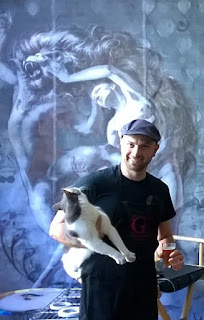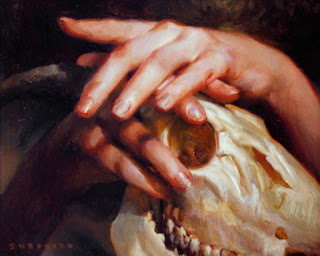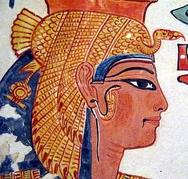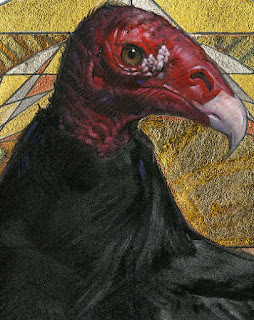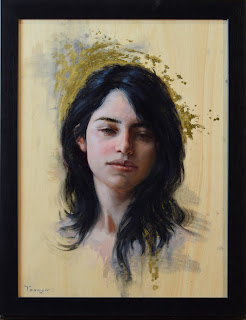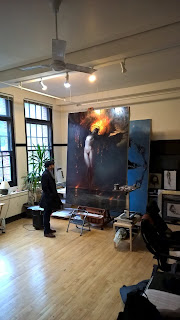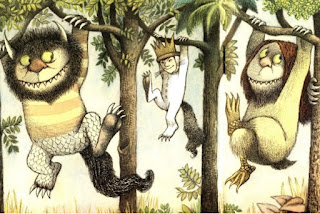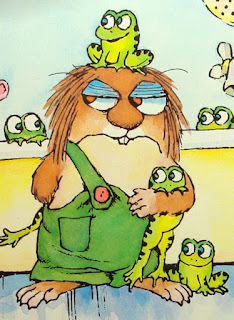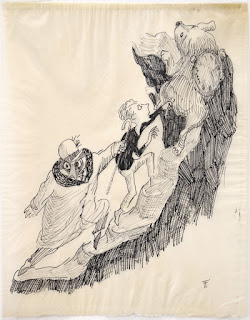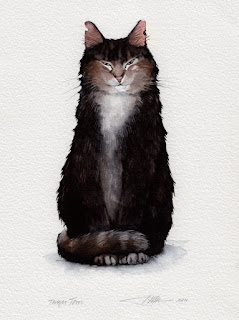Tenaya. Who?
You can't find much about him online, unless it pertains to his teaching at
The Georgetown Atelier in Seattle, a school he founded about seven years ago, tucked away in the corner of an old brick brewery building. No website, very little social media presence, very little press. So how on earth did I find this guy with the weird name? Glad you asked!
Let's hop in the DeLorean and time travel to 2007, where I am scoping out a potential studio space on the second floor of a historic building in the odd and wonderful neighborhood of Georgetown in south Seattle. As I'm looking at a space in the collective known as Georgetown Art Center, one of the studio doors pops open and this young, swaggering1 guy steps out. The GAC director introduces me to one of her art tenants, Tenaya Sims. "Go check out his work," she waves me into his space, "it's breathtaking". I walk in and am met with oil paintings of such pristine quality, I can't believe this guy actually painted them. He explains he recently graduated from the
Juliette Aristides atelier, and I'm doubly impressed. After all, she literally wrote the books on atelier drawing and painting. I realized at that moment that this was the place I needed to be; all the art in this space was fantastically good, and I needed to be surrounded by really good works.
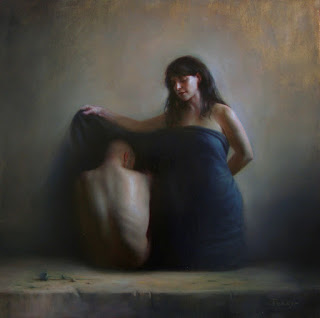 |
| "Thistle", oil on canvas. I got to know Tenaya at about this time. |
Not too long after that, Tenaya asked me if I'd
consider modeling for a painting he was working on. It wasn't a nude gig
so I agreed, and it was about this time we started to interact a little
more than just saying hello. He was in his late 20s at the time, and a
very confident realist painter, although he was still exploring the direction he wanted to go with his work. He was working as a part-time
instructor at the Fall City Arts studio, something that he expanded into the Georgetown Atelier a couple years later, taught by Tenaya
other graduates from his full time program. He truly believed anyone with the
will to study could learn classical technique in drawing and painting,
and I wound up taking lessons from Tenaya, as I knew my own technique
needed some updating.
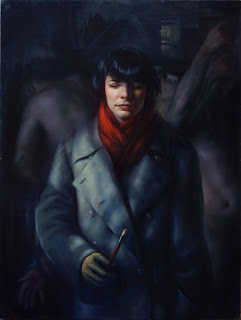 |
| "Maquette", oil on linen on board. I also modeled for this one, and actually worked on the painting while he was out of the country (he was putting it into the A/NT Gallery "Pain" show of 2014 but couldn't finish on time). Its signed by the both of us. |
Soon after, he and I became friends. We have a funny
friendship: we're both incredibly stubborn, so arguments, often heated,
erupt on a regular basis. But like a tropical storm, it blows over
quickly and within just a few minutes we'll interact as if nothing
happened. Sometimes his playful natures extends into extreme pestering, in which case my bossy, older-sister side responds (think Linus and Lucy van Pelt).
We both like to be right, but when it comes to painting and drawing, he
most definitely knows what he's talking about, and I'll defer to him.
The results in my current painting process speaks to this.
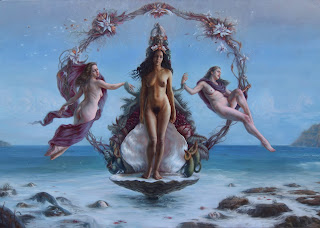 |
| "The Birth of Venus", oil on linen. It's over 8 feet in width and took over a year to paint. |
Okay, we'll hop back into the DeLorean and its 2015. Tenaya had been working out all the kinks in his first major oversized piece,
The Birth of Venus, and began working on his next one, the current
Semillas. I had just gotten back from Spectrum Fantastic Art Live in Kansas City, and I met up with Tenaya for coffee. I was gushing about how awesome the trip was and all the amazing people I met, and talked about the kinds of shows I wanted to book. Tenaya asked me if he could show with me; I was taken aback, mostly because Tenaya has always been a realist painter and I am hardly the typical classical establishment. He quickly reminded me of his years working in the video game industry storyboarding and concepting, followed by a BFA at Carnegie Mellon (including working with Randy Pausch) before training under Jeff Watts and Juliette.
Okay, okay, point taken!! I made him swear that he would be able to complete a body of work in time - he swore he would - and if so, he had a year
to prepare.
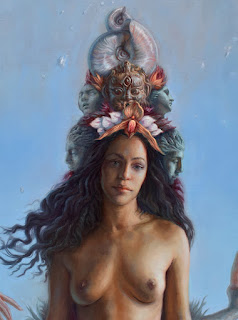 |
| "The Birth of Venus", detail |
When Tenaya works on a major piece, regardless of size, he makes many many little studies, whether from a live model, photographic reference or a combination of the two. From these, he'll work on his values, creating several monochromatic drawings and paintings to gauge just the right set of values and tones for his work. He'll hunt out additional resource images -- a tree, a cloud, the ocean -- and with all these he starts to build up his composition, usually in Photoshop, first seaming together photographic reference, then digitally painting the composition, working out color, temperature, and layout. He'll paint several color studies, working back and forth digitally to traditionally. From all of this, he'll then start on the actual painting process, which is quite academic in nature. All said, for his oversized works the process can take up to a year on a given painting, but the result is worth every minute.
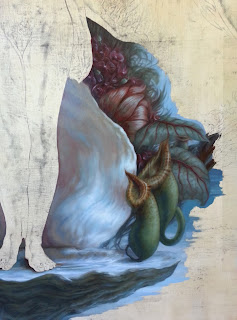 |
| Once Tenaya worked out the composition on a smaller scale, he could then tackle the final canvas |
Women are predominant subjects for him; classically, the female figure, especially the nude, represents all that is beautiful. Tenaya takes particular influence from his ancestral Italy, with artists such as Caravaggio, Michelangelo and Botticelli fueling his imagination. He is also a great admirer of later artists, such as the Victorian painters Waterhouse and Bouguereau, whose sublime skintones move even the smallest of hearts. To render the female figure to her greatest attributes (which goes beyond her physical features) is the goal of all classically trained artists. She is powerful, serene, motherly, earth-shattering, impish, sexy, a goddess. The nude, as opposed to a clothed model, is timeless; she is neither ancient nor contemporary.
 |
| William Bouguereau, "The Birth of Venus", 1879. Venus' skin reflects the pearlescence of the oyster shell. Bougureau defined English beauty during his lifetime. |
Working with Indo-European mythical themes, Tenaya's newest works reflect the various divine roles that women have played. With "Venus", its quite apparent; up rises Venus in the half shell, however, she is dark skinned, more somber. Below her in the foam are seemingly lifeless women; this new Venus replaces older and outdated definitions of what is beautiful and desirable. In "Semillas" (meaning "seed" in Spanish), Tenaya works with the power of the great goddess Kali, who is in a midpoint fall (or perhaps rise?). Hot, slag-like fiery sparks fall from the sky, each contained a tiny, perfect figure in a fetal position. She represents the destruction and rebirth that Kali is revered for, in dramatic, epic form.
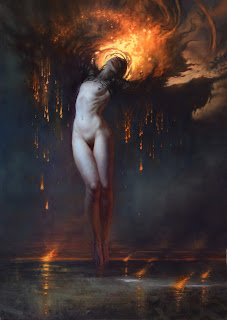 |
| "Semillas", oil and 23k gold leaf on panel. This piece is 72 x 101". |
 |
| "Semillas", detail |
Tenaya made the attempt to finish a third oversized painting, having to stop prior to completion due to the constraints of time. We are displaying it anyway, giving the visitor a rare peek at a painting in mid-process. As-yet unnamed, this third painting depicts a woman fighting an anthropomorphic lion, their manes flowing into one another and terminating into a tail of feathers. Does the lion represent the Nemean lion of Greek mythology, defeated by Hercules and eventually becoming the constellation Leo? I'm not really sure, but it does a respectful nod to Rubens' rendition of this mythic battle..
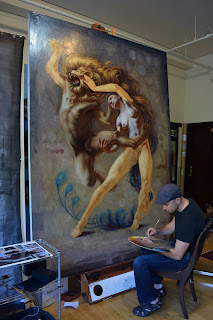 |
| Working on the as-yet unnamed oversized painting |
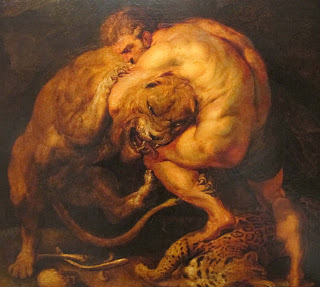 |
| Peter Paul Rubens, "Hercules Strangling the Nemean Lion", 1639. |
Tenaya has several smaller works, such as the modestly sized "Linea" (55 x 38.5") or the portrait "Huyen", and all of them are exquisite. I don't believe Tenaya is done with big paintings, though. In fact, I think they're going to get bigger, grander.
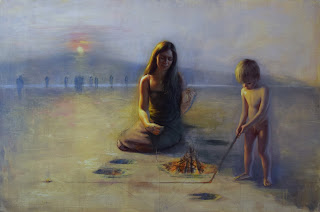 |
| "Linea", oil on linen mounted on panel. |
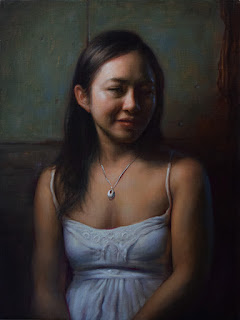 |
| "Huyen", oil on linen mounted on panel. |
You can tell he enjoys the process of working in larger scale. The brush
strokes are a little looser as the size grows but no less mindful and
exacting. To see his newest pieces is an experience; we've deliberately
opened up the gallery floor to allow the visitor to step back at least
fifteen feet and drink in the work. Its very powerful, and I've had more than one visitor come back to the gallery with friends in tow, standing back to enjoy the looks their friends make when addressing these paintings.
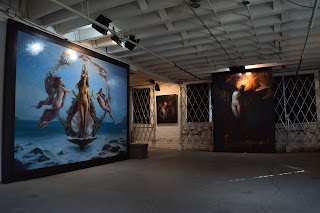 |
| Krab Jab Studio makes use of open space |
He definitely rolled up his sleeves and went to work this
last year, and his solo show of thirteen drawings and paintings is
tight, beautifully painted, and exciting, which is the last adjective
you'd consider for a realist painter of classical bend. He's taking on
narratives, crossing that bridge between conservative realism to
imaginative realism, a journey of which he's an enthusiastic
participant. As his friend, I'm excited for him, and as his curator, I'm quite pleased.
So why isn't there a website for him, or much of an online presence? He doesn't like to think about those things; he finds the internet to be highly distracting, and if it weren't for his school's site, he would do without the web, with the exception of TED Talks, visual research or streaming radio. Getting him to do anything beyond teaching, eating or painting is sometimes a futile task (he will, however, take you up on a game of squash if asked).
~ Julie Baroh, June 2016
"The Art of Tenaya Sims" runs through July 2nd at Krab Jab Studio. For sales inquiries please contact
Natalia Fedoruk.












